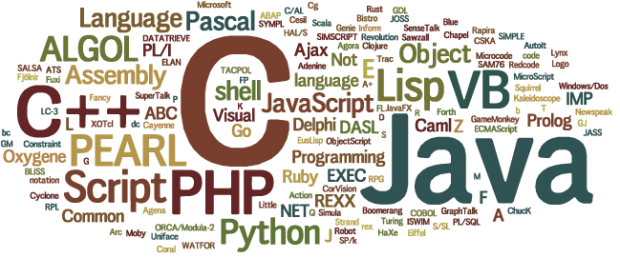- Published on
Classification of Programming Languages
- Authors
- Name
- Cristian Encalada

It's interesting to understand the many ways in which software can be built. It helps you think in new and creative ways, outside of the tools you're used to.
Classification is important because it allow you to better understand relationships and connections between things.
This article will be a brief introduction with short examples. The objective is to start seeing a bigger picture, which can make it easier to understand different related topics in the programming world.
Table of contents
- What is a programming paradigm?
- Imperative languages
- Procedural languages
- Functional languages
- Declarative languages
- Object-oriented languages
Classification by purpose
General-purpose languages
These are programming languages that can be used for a wide variety of tasks. They're like "Swiss army knives" of coding, capable of handling many different types of programs. Examples include Python, Java, and C++.
print("Hello, World!")
Domain-specific languages
These languages are designed for specific tasks or industries. They're like tools designed for a particular job. Examples include SQL for working with databases and HTML for building web pages.
SELECT * FROM customers;
Classification by level
Machine language
This is the lowest-level language that computers understand directly. It's made up of binary code (0s and 1s) and controls the hardware. This is a "simple" machine language instruction to add two numbers:
00011001 00000010 00000011
Low-level languages
These are more human-readable versions of machine language. They still deal with hardware specifics but use words and symbols. Assembly language is an example:
org 0x100 ; .com files always start 256 bytes into the segment
; int 21h is going to want...
mov dx, msg ; the address of or message in dx
mov ah, 9 ; ah=9 - "print string" sub-function
int 0x21 ; call dos services
mov ah, 0x4c ; "terminate program" sub-function
int 0x21 ; call dos services
msg db 'Hello, World!', 0x0d, 0x0a, '$' ; $-terminated message
High-level languages
These languages are more like human language and abstract away hardware details. They're easier for programmers to use. This is an example in Python:
x = 5
y = 3
result = x + y
Classification by compilation
Interpreted languages
In these languages, code is executed line by line by an interpreter. It reads the code and performs actions immediately. JavaScript is an interpreted language:
console.log("Hello, World!");
Compiled languages
Code in these languages needs to be translated into machine language before running. This compilation step happens before execution. An example is C:
#include <stdio.h>
int main() {
printf("Hello, World!\n");
return 0;
}
Classification by paradigm
What is a programming paradigm
Imagine programming paradigms as different recipes for cooking. Each recipe follows a specific method, uses certain ingredients, and has its own style. Similarly, programming paradigms provide guidelines for creating software in different ways, depending on what you're trying to achieve and how you prefer to work.
A programming paradigm is like a set of rules and approaches that help you solve problems with code. It's like choosing a specific way of thinking and building your programs.
Some of the most famous paradigms are explained below.
Imperative languages
These languages tell the computer how to do something step by step. You give explicit instructions. C is an imperative language:
int main() {
int x = 5;
int y = 3;
int result = x + y;
return 0;
}
Procedural languages
They organize code into procedures or functions. Each function performs a specific task. Pascal is a procedural language:
program AddNumbers;
var
x, y, result: integer;
begin
x := 5;
y := 3;
result := x + y;
end.
Functional languages
These focus on functions as the main building blocks of programs. Functions can't change data; they return new values. An example is Haskell:
addNumbers :: Int -> Int -> Int
addNumbers x y = x + y
Declarative languages
You describe what you want to achieve, not how to achieve it. SQL is a declarative language:
SELECT name FROM customers WHERE age > 18;
Object-oriented languages
These focus on objects that represent real-world things and their interactions. Java is an object-oriented language:
class Animal {
String name;
void speak() {
System.out.println("Animal sound");
}
}
Conclusion
Programming languages can often support multiple paradigms or fit into different classification types. A programming language can be flexible and adaptable, allowing programmers to use different programming styles within the same language.
For example, a programming language like
Pythoncan be used for both imperative and object-oriented programming paradigms. It supports different ways of solving problems based on what the programmer wants to achieve. Similarly, a language can be both compiled and interpreted, depending on how it's used.This
flexibilityallows programmers to choose the best approach for their specific tasks and projects.
Thanks for reading!